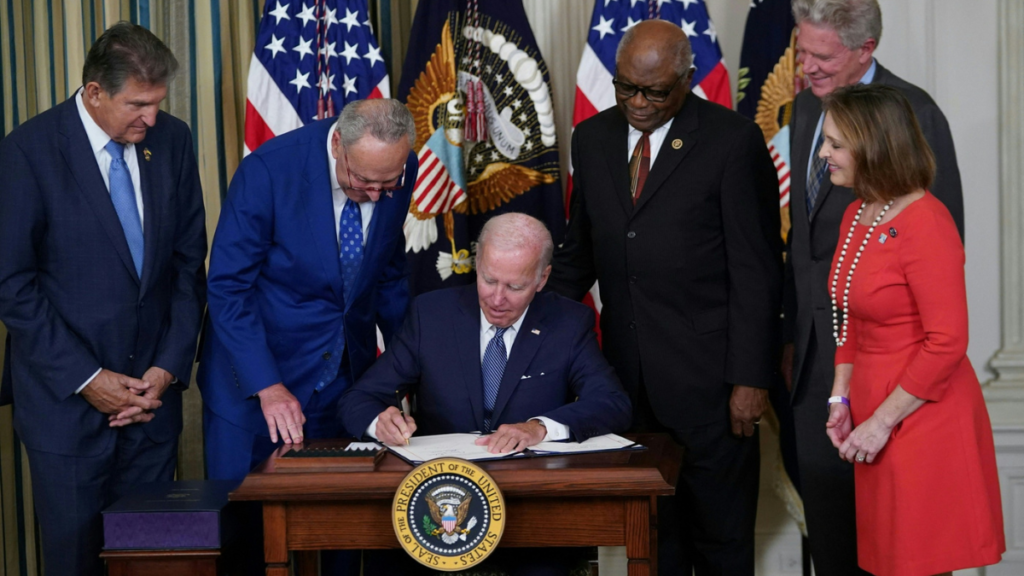The 2022 Biden’s Climate Law has significantly accelerated clean-energy investments and created a new market for green tax credits. This marketplace, facilitated by Wall Street, could facilitate up to $80 billion annually, directing investments towards technologies crucial for reducing fossil fuel emissions and combating climate change. The law introduced innovative tax incentives for clean energy, allowing smaller companies to sell their tax credits to larger corporations with substantial tax liabilities. The market is currently in full swing, with clean-energy companies receiving cash injections to fuel their projects. However, the selling price is often less than the actual value of the tax credits, with various financial intermediaries taking their share.
The Inflation Reduction Act (I.R.A.) has fueled excitement and growth in the market, with online start-up platforms emerging as intermediaries between buyers and sellers of tax credits. Critics argue that the law allows major corporations to reduce their tax liabilities, potentially contradicting President Biden’s pledge to make corporate America pay more. The I.R.A. has created a shift in the landscape, making it easier for companies to buy and sell tax credits. Entrepreneurs like Alfred Johnson emphasize the need for increased market participation to ensure the law’s success.
Creating a Financial Trading Marketplace
The 2022 Biden’s Climate Law strategically crafted a financial trading marketplace, acting as a catalyst for smaller companies to secure essential funding. However, the unique twist lies in Wall Street’s involvement, where major banks and financial firms take a cut from these transactions. Analysts project that this marketplace could facilitate up to $80 billion annually, steering investments towards technologies crucial for reducing fossil fuel emissions and combating climate change.
Innovative Tax Incentives for Clean Energy
To incentivize the production and installation of low-emission energy technologies like solar and wind, the law introduced a gamut of tax incentives. Recognizing that these incentives might not benefit smaller or less profitable companies that lack sufficient tax liabilities, lawmakers devised an innovative workaround. These companies can now sell their tax credits to larger corporations with substantial tax liabilities, creating a thriving marketplace.
The Dynamics of the Tax Credit Marketplace
The market is in full swing, with clean-energy companies receiving cash injections to fuel their projects. However, the selling price is often less than the actual value of the tax credits, with various financial intermediaries taking their share. Clean-energy and financial analysts reveal that major corporations are currently paying between 75 and 95 cents on the dollar to lower their federal tax bills, a testament to the growing demand in this burgeoning market.
Factors Influencing Tax Credit Costs
Several factors influence the cost of these tax credits, including project size and risk. Larger projects command a higher percentage, and additional fees for lawyers, banks, and other intermediaries further dilute the value for sellers. To mitigate risk, buyers increasingly require sellers to purchase insurance, especially in cases where projects might not deliver the anticipated tax benefits.
Excitement and Growth in the Market
The potential for an $80 billion market has fueled excitement, giving rise to a new industry around the Inflation Reduction Act (I.R.A.). Online start-up platforms, acting as intermediaries between buyers and sellers of tax credits, have rapidly emerged. A recent renewable energy tax credit conference saw record attendance, underscoring the growing interest in this market. Entrepreneurs, including former Biden administration officials and individuals from the tech industry, are venturing into a field that combines finance with green energy.
Environmental Gains vs. Corporate Tax Reductions
While the marketplace expands financing opportunities for emissions-reducing technologies, it raises questions about its impact on corporate tax bills. Critics argue that the law allows major corporations to reduce their tax liabilities, potentially contradicting President Biden’s pledge to make corporate America pay more. Despite this, supporters highlight the unexpected brilliance of bringing sophisticated financial interests and investors into the realm of funding green energy.
Government Checks vs. Tax Credits
Some proponents of the climate law had initially advocated for direct government checks equivalent to the tax benefits for companies lacking sufficient tax liability. However, this proposal was rejected, emphasizing the unique approach taken by the legislation to stimulate the market. The I.R.A. has effectively created a shift in the landscape, making it easier for companies to buy and sell tax credits.
The Rise of Online Exchanges
Before the climate law, a modest federal marketplace for certain tax credits existed. However, the I.R.A. expanded this market, attracting new players and making transactions more accessible. Large banks continue to dominate significant transactions, but entrepreneurs are developing online exchanges that function like matchmaking platforms for tax credits. Companies outline project specifications, and buyers bid for credits, creating a dynamic marketplace.
Ensuring Transparency and Valid Investments
To sell tax benefits under the law, companies must register their credits with the Treasury Department. The online platforms connecting buyers and sellers, however, remain unregulated by the government. Entrepreneurs like Alfred Johnson, co-founder of Crux, emphasize the need for increased market participation to ensure the law’s success. Transparency in presenting available projects and their estimated values is crucial for assuring taxpayers that their support is driving valid clean-energy investments.
Conclusion: A Growing and Evolving Market
President Biden’s signature climate law has not only accelerated clean-energy investments but has also given rise to a thriving market for green tax credits. As this market continues to grow, entrepreneurs, major corporations, and financial players are navigating the intricacies of this new landscape. While debates persist regarding the impact on corporate tax bills, the undeniable success of this marketplace lies in its ability to bring together financial interests and investors for the collective goal of funding green energy initiatives. The Inflation Reduction Act has set the stage for a new era where environmental consciousness intersects with financial innovation on Wall Street.







